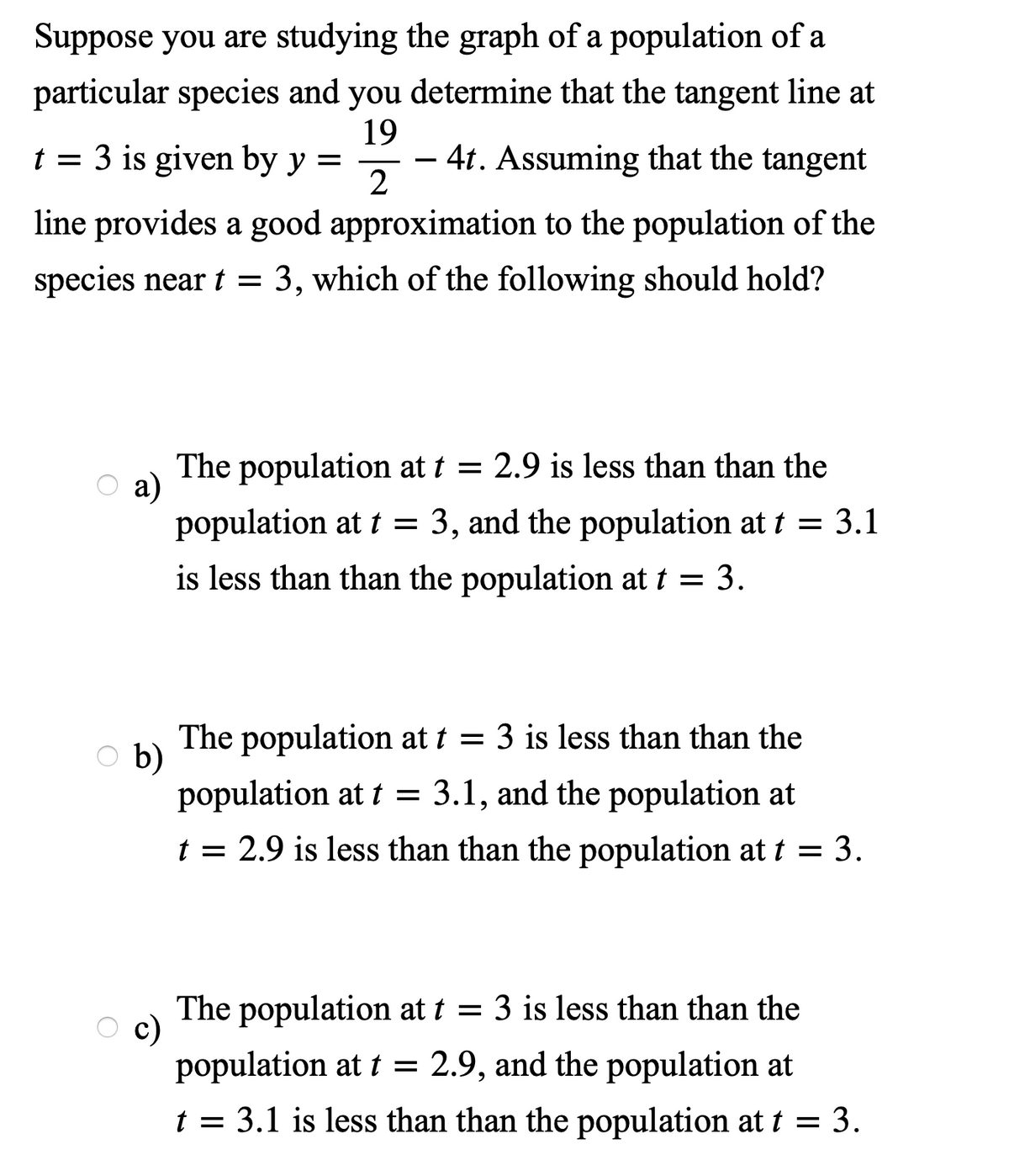Suppose you are studying the graph of a population of a particular species and you determine that the tangent line at t = 3 is given by y = 19 - 4t. Assuming that the tangent - line provides a good approximation to the population of the species near t = 3, which of the following should hold? The population at t = 2.9 is less than than the а) population at t = 3, and the population at t = 3.1 is less than than the population at t = 3. The population at t = 3 is less than than the b) population at t = 3.1, and the population at t = 2.9 is less than than the population at t = 3. The population at t = 3 is less than than the population at t = 2.9, and the population at t = 3.1 is less than than the population at t = 3.
Suppose you are studying the graph of a population of a particular species and you determine that the tangent line at t = 3 is given by y = 19 - 4t. Assuming that the tangent - line provides a good approximation to the population of the species near t = 3, which of the following should hold? The population at t = 2.9 is less than than the а) population at t = 3, and the population at t = 3.1 is less than than the population at t = 3. The population at t = 3 is less than than the b) population at t = 3.1, and the population at t = 2.9 is less than than the population at t = 3. The population at t = 3 is less than than the population at t = 2.9, and the population at t = 3.1 is less than than the population at t = 3.
Algebra & Trigonometry with Analytic Geometry
13th Edition
ISBN:9781133382119
Author:Swokowski
Publisher:Swokowski
Chapter7: Analytic Trigonometry
Section7.6: The Inverse Trigonometric Functions
Problem 91E
Related questions
Question

Transcribed Image Text:Suppose you are studying the graph of a population of a
particular species and you determine that the tangent line at
19
- 4t. Assuming that the tangent
2
= 3 is given by y =
-
line provides a good approximation to the population of the
species near t = 3, which of the following should hold?
The population at t = 2.9 is less than than the
а)
population at t =
3, and the population at t = 3.1
is less than than the population at t = 3.
The population at t = 3 is less than than the
b)
population at t = 3.1, and the population at
t = 2.9 is less than than the population at t = 3.
The population at t = 3 is less than than the
c)
population at t =
2.9, and the population at
t = 3.1 is less than than the population at t = 3.

Transcribed Image Text:The population at t = 3 is less than than the
O d) population at t = 3.1, and the population at
t = 2.9 is greater than than the population at
t = 3.
Expert Solution
This question has been solved!
Explore an expertly crafted, step-by-step solution for a thorough understanding of key concepts.
This is a popular solution!
Trending now
This is a popular solution!
Step by step
Solved in 2 steps with 2 images

Knowledge Booster
Learn more about
Need a deep-dive on the concept behind this application? Look no further. Learn more about this topic, calculus and related others by exploring similar questions and additional content below.Recommended textbooks for you

Algebra & Trigonometry with Analytic Geometry
Algebra
ISBN:
9781133382119
Author:
Swokowski
Publisher:
Cengage

Functions and Change: A Modeling Approach to Coll…
Algebra
ISBN:
9781337111348
Author:
Bruce Crauder, Benny Evans, Alan Noell
Publisher:
Cengage Learning

Trigonometry (MindTap Course List)
Trigonometry
ISBN:
9781337278461
Author:
Ron Larson
Publisher:
Cengage Learning

Algebra & Trigonometry with Analytic Geometry
Algebra
ISBN:
9781133382119
Author:
Swokowski
Publisher:
Cengage

Functions and Change: A Modeling Approach to Coll…
Algebra
ISBN:
9781337111348
Author:
Bruce Crauder, Benny Evans, Alan Noell
Publisher:
Cengage Learning

Trigonometry (MindTap Course List)
Trigonometry
ISBN:
9781337278461
Author:
Ron Larson
Publisher:
Cengage Learning